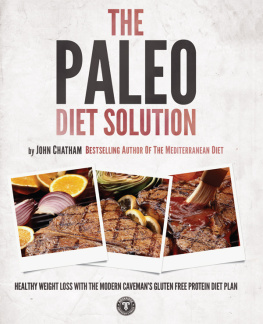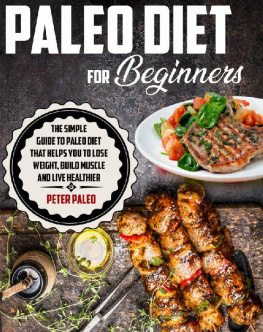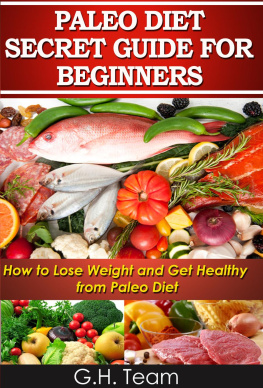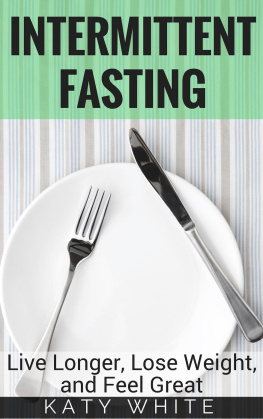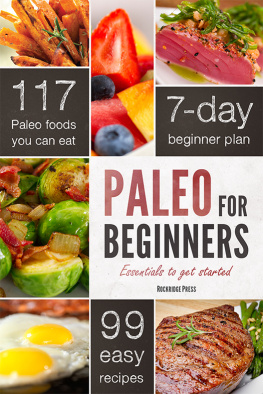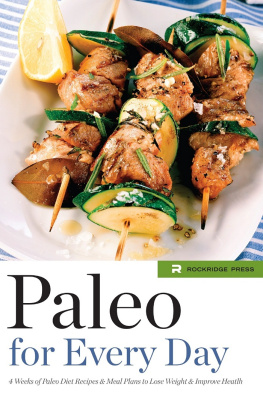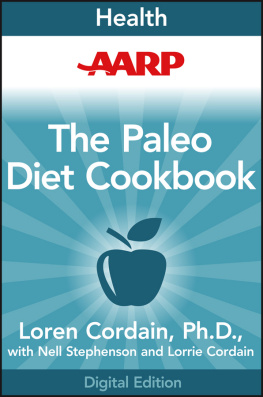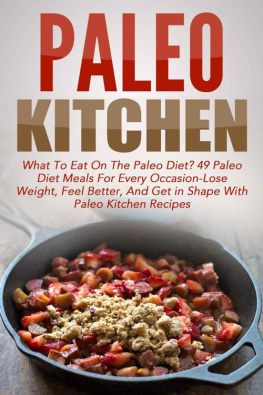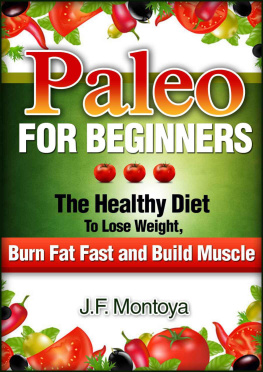The Paleo Diet Solution
Healthy Weight Loss with the Modern Cavemans Gluten Free Protein Diet Plan
by John Chatham
Bestselling Author Of The Mediterranean Diet

Rockridge University Press
Copyright 2012 by Rockridge University Press, Berkeley, California
No part of this publication may be reproduced, stored in a retrieval system or transmitted in any form or by any means, electronic, mechanical, photocopying, recording, scanning or otherwise, except as permitted under Sections 107 or 108 of the 1976 United States Copyright Act, without the prior written permission of the Publisher. Requests to the Publisher for permission should be addressed to the Permissions Department, Rockridge University Press, 918 Parker St, Suite A-12, Berkeley, CA 94710.
Limit of Liability/Disclaimer of Warranty: The publisher and the author make no representations or warranties with respect to the accuracy or completeness of the contents of this work and specifically disclaim all warranties, including without limitation warranties of fitness for a particular purpose. No warranty may be created or extended by sales or promotional materials. The advice and strategies contained herein may not be suitable for every situation. This work is sold with the understanding that the publisher is not engaged in rendering medical, legal, or other professional advice or services. If professional assistance is required, the services of a competent professional person should be sought. Neither the publisher nor the author shall be liable for damages arising here from. The fact that an individual, organization or Web site is referred to in this work as a citation and/or a potential source of further information does not mean that the author or the publisher endorses the information the individual, organization or Web site may provide or recommendations they/it may make. Further, readers should be aware that Internet Web sites listed in this work may have changed or disappeared between when this work was written and when it is read.
For general information on our other products and services or to obtain technical support, please contact our Customer Care Department within the U.S. at (866) 744-2665, or outside the U.S. at (510) 253-0500.
Rockridge University Press publishes its books in a variety of electronic and print formats. Some content that appears in print may not be available in electronic books, and vice versa.
TRADEMARKS: Rockridge University Press and the Rockridge University Press logo are trademarks or registered trademarks of Callisto Media Inc. and/or its affiliates, in the United States and other countries, and may not be used without written permission. All other trademarks are the property of their respective owners. Rockridge University Press is not associated with any product or vendor mentioned in this book.
ISBN: 978-1-62315-004-4
Section One
An Introduction to the Paleo Diet
- What is the Paleo Diet?
- How the Paleo Diet Came About
- What the Paleo Diet Can Do For Your Health
- The Paleo Diet and Allergies
- The Paleo Diet and Weight Loss
- The Paleo Diet for Athletes
- What About All That Fat?
Chapter 1
What is the Paleo Diet?
T he Paleo or Paleolithic Diet goes by several names. Its also commonly called the Stone Age Diet, the Caveman Diet or the Hunter-Gatherer Diet. Regardless of the name used, it is a diet based on what is known and what is assumed about the daily diet of man prior to the age of agriculture. The diet gets its most common title from the age known as the Paleolithic Era, a time that spanned from about 2.5 million years ago to about 10,000 years ago, when man started to grow crops as a source of food.
The Paleo Diet guidelines are based on a pattern of eating that attempts to replicate, as closely as is possible in modern times, a diet based on foods that could have been hunted, fished or foraged in the wild during this pre-agricultural age. These foods include wild game, meats, fish and shellfish, eggs, fruits and vegetables, mushrooms, tree nuts, seeds, herbs and honey.
There are several variations of the Paleo Diet, which differ in how strictly they adhere to the most stringent guidelines. The original Paleo Diet excludes all grains, dairy, legumes (beans) and sugar. Some more flexible versions allow for a very limited amount of grains, legumes or dairy, but most versions either exclude them completely or only allow them in the very smallest quantities.
All variations of the Paleo Diet forbid any processed foods, alcohol or sugar.
The premise behind the Paleo Diet is the theory that we are not genetically wired to process foods such as legumes, grains and dairy and that many of the health issues we face today are a result of eating foods to which our bodies are not truly adapted. These health issues, such as obesity, diabetes and heart disease, are often referred to as diseases of affluence. This is because they are most common, and even considered epidemic, in the wealthier nations, where people eat rich diets far removed from the land.
The creators of the various versions of the Paleo Diet claim that many of these nutrition-related diseases can be avoided or aided by following this pattern of eating. A good deal of research supports this claim. As a side benefit, the Paleo Diet can also help followers to lose weight, although its main purpose is good health; primarily good cardiovascular health and a stronger immune system.
The Paleo Diet does require commitment and creativity, as it means giving up many of the foods and ingredients that most Americans are used to eating on a daily basis. Adjusting to this pattern of eating and finding suitable substitutes for off-limit foods can take some time and a good deal of trial and error. However, the benefits to your health, weight and feeling of wellbeing make that time and effort well worthwhile.
Chapter 2
How the Paleo Diet Came About
T he Paleo Diet has become enormously popular in the last few years and has garnered quite a bit of media attention. However, the Paleo Diet is far from a newcomer to the nutrition/diet arena. In fact, its more than thirty years old.
The Beginning of a New Way to Eat
In 1975, gastroenterologist Walter L. Voegtlin published his book, The Stone Age Diet, in which he presented a convincing case for returning to a diet more like that followed by peoples of the Paleolithic Era. In the book, Dr. Voegtlin presented several examples of his treatment of digestive ailments such as colitis, irritable bowel syndrome and Crohns disease with a diet that relied primarily on animal fats and proteins and a very low intake of carbohydrates.
In the 70s, it was almost universally believed that the only healthy diet was one that was low in fat and calories, so the Stone Age Diet didnt make much of an impact on mainstream thought.
The Caveman Goes Mainstream
In 1985, however, Boyd Eaton and Melvin Konner, of Emory University, published an article in The New England Journal of Medicine that did gain a great deal of attention in both the media and the public. Their paper was a study of Paleolithic nutrition that led to the 1988 release of their book, The Paleolithic Prescription: A Program of Diet & Exercise and a Design for Living. This book became the foundation for todays many variations of the Paleo Diet.
In the book, the authors explained the components and benefits of the Paleolithic Era diet, although their recommendation was to reproduce the pattern and macronutrient content of the diet using modern foods, rather than excluding any foods that would not have been available to people of the Stone Age. This book was quickly followed by their second book,

